The King of Fighters (KOF) is a series of fighting games by SNK that began with the release of The King of Fighters '94 in 1994. The series was developed originally for SNK's Neo Geo MVS arcade hardware. This served as the main platform for the series until 2004 when SNK retired it in favor of the Atomiswave arcade board. Two King of Fighters games were produced for the Atomiswave platform (The King of Fighters Neowave and The King of Fighters XI) before SNK decided to discontinue using it for the series. The series' most recent arcade hardware is the Taito Type X2, first used with the release of The King of Fighters XII. Ports of the arcade games and the original The King of Fighters games have been released for several video game consoles. The latest entry in the series, The King of Fighters XV, was released in February 2022.
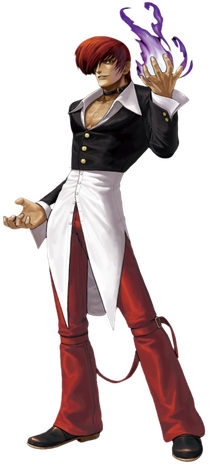
Iori Yagami is a character from SNK's The King of Fighters video game series. The character first appeared in The King of Fighters '95 as the leader of the Rivals Team, as the initial enemy and later rival of Kyo Kusanagi. Iori is the heir of the Yagami clan, who use pyrokinetic powers and sealed the Orochi devil along with the Kusanagi and Yata clans. Iori suffers from a curse – "The Riot of the Blood" – under which he becomes faster, stronger and wilder, exhibiting a deadly tendency to indiscriminately attack everyone in close proximity. In this state, Iori is commonly called "Wild Iori" or "Orochi Iori". Aside from the main series, Iori appears in several other media series, including spin-offs, crossover video games and comic adaptations of the series.
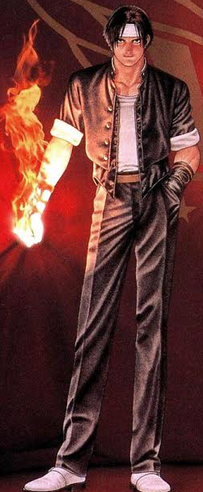
Kyo Kusanagi is a fictional character in SNK's The King of Fighters series of fighting games. The character was first introduced in the 1994 video game The King of Fighters '94 as the leader of the Japan team from the series' title tournament. Kyo, heir to the Kusanagi clan, is first introduced as a cocky, delinquent high-school student who has pyrokinetic powers. His clan is one of three who banished the legendary snake demon entity Yamata no Orochi. During the series' story, Kyo meets rivals and enemies who seek to take his flame abilities. Aside from the main series, Kyo appears in several crossovers and spinoffs with other games. He is also the central title character of the manga The King of Fighters: Kyo and video game adaptation with the same name which center around his daily life.
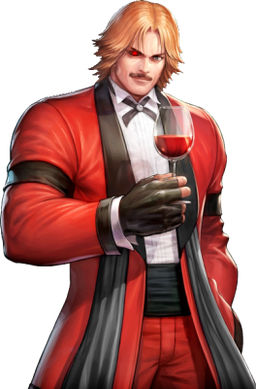
Rugal Bernstein is a video game character created by SNK. First introduced in The King of Fighters '94, he is a recurring boss in The King of Fighters fighting game series, appearing in some titles as an enhanced version called Omega Rugal. As the host of the tournaments from The King of Fighters '94 and '95, Rugal plans to turn all the competitors from the tournament into stone statues as part of his collection. Despite his death in '95, Rugal is still featured in The King of Fighters titles which do not contain a storyline. He has also been featured in the Capcom vs. SNK series as a boss character.

Capcom vs. SNK 2: Mark of the Millennium 2001 is the sequel to the fighting game Capcom vs. SNK. It was originally released on NAOMI hardware in arcades, with Sega handling the American arcade release. As in the original, players select a team of fighters from various Capcom and SNK games then fight other teams, winning each battle by defeating all the opponents from the other team.

The King of Fighters '97(KOF '97) is a fighting game produced by SNK for the Neo Geo arcade and home console in 1997. It is the fourth game in The King of Fighters series. It was ported to the Neo Geo CD, as well as the PlayStation and the Sega Saturn in Japan only.

The King of Fighters '98: The Slugfest, known in Japan as The King of Fighters '98: Dream Match Never Ends , is a fighting game released by SNK for the Neo Geo arcade and home consoles in 1998. It is the fifth game in The King of Fighters series. It was advertised by SNK as a "special edition" of the series, as it featured most of the characters who appeared in the previous games.

The King of Fighters '99: Millennium Battle is a 1999 fighting game developed and published by SNK for the Neo Geo MVS arcade and home consoles in 1999. It is the sixth installment in The King of Fighters series, introducing a new story arc known as the "NESTS Chronicles" which is centered around a young man named K', who is formerly associated with a mysterious yet threatening organization known only as NESTS. The game introduces several changes to the established KOF format, most notably an assisting character labeled "Striker". The game was ported to the Neo Geo CD and the PlayStation. Dreamcast and Microsoft Windows versions were also released under the title The King of Fighters' 99: Evolution whose stages were remodeled in 3D.

The King of Fighters XI(KOF XI) is a 2D fighting game produced by SNK Playmore. It is the eleventh installment in The King of Fighters series following The King of Fighters 2003. It was originally released as a coin-operated arcade game for the Atomiswave platform in 2005. A home version for the PlayStation 2 was released in Japan in 2006, followed by releases in the PAL region and North America in 2007. It is the second The King of Fighters game to not run on the Neo Geo following its predecessor, The King of Fighters Neowave and also the first major canonical entry to not be named after its year of release.

The King of Fighters '96(KOF '96) is a fighting game released by SNK for the Neo Geo arcade and home consoles in 1996. It is the third game in The King of Fighters series, following The King of Fighters '95. Like its predecessor, the game was ported to the Neo-Geo CD, as well as the PlayStation and Sega Saturn. Unlike the previous game, the PlayStation and Saturn versions were released only in Japan, with a language setting allowing the player to set the game to English.
The King of Fighters 2001(KOF 2001, or KOF '01) is a fighting game produced by Eolith for the Neo Geo. It is the eighth game in The King of Fighters series, the third and final part of the "NESTS Chronicles" story arc, and the first game produced following the closure of the original SNK. The game was produced by the South Korea-based company Eolith and developed by Eolith and BrezzaSoft, a company formed by former SNK employees. For this reason, the SNK logo is displayed at the opening, but SNK's development staff is not involved in the production of the game itself at all, except for the game sound. Due to the influx of Korean capital, its influence can be seen in the participating characters. The game was ported to the Sega Dreamcast in Japan only and PlayStation 2. The stand-alone PlayStation 2 version was released in North America and in Europe in a two-in-one bundle with the preceding game in the series, The King of Fighters 2000. Both the original Neo Geo version and the Sega Dreamcast version were included in The King of Fighters NESTS Hen compilation released for the PlayStation 2 in Japan.

The King of Fighters 2002: Challenge to Ultimate Battle(KOF 2002, or KOF '02) is a fighting game developed by Eolith and published by Eolith and Playmore for the Neo Geo in 2002. It is the ninth game in The King of Fighters series and the second one to be produced by Eolith. The game was ported to the Dreamcast, PlayStation 2, and the Xbox, where in the PS2 and Xbox versions were released in North America in a two-in-one bundle with the following game in the series, The King of Fighters 2003. The Dreamcast port was released only in Japan, it was also the last game in the series to be officially released for the Japanese Dreamcast.
The King of Fighters 2003(KOF 2003, or KOF '03), also known by fans as The King of Fighters X, is a fighting game produced by SNK Playmore for the Neo Geo arcade and home platforms in 2003. It is the tenth game in The King of Fighters series and the last one released for the Neo Geo, which served as the primary platform for the series since The King of Fighters '94. It was ported to the PlayStation 2 and Xbox, and was released on both consoles in North America in a two-in-one bundle with the preceding game in the series, The King of Fighters 2002.
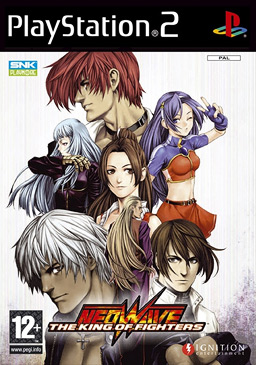
The King of Fighters Neowave(KOF Neowave, or KOF NW) is a 2D fighting game produced by SNK Playmore and released as a coin-operated arcade game for Sammy's Atomiswave hardware in 2004. It was the first game SNK Playmore produced for the Atomiswave. This is a remake of The King of Fighters 2002 with a major change of roster and stages, the game was also made on the PlayStation 2 and Xbox. The PS2 version was released only in Japan and the PAL region, the Xbox version was released both in Japan and North America. The North American version was released on April 18, 2006. In 2020, a Dreamcast homebrew adaptation of the arcade version was also made possible due to the Dreamcast sharing almost identical hardware with its Atomiswave cousin. The character artwork was done by Tomokazu Nakano. In Japan, it was the last game to be released for the Xbox.

The King of Fighters '94 is a fighting game released by SNK for the Neo Geo MVS arcade system in 1994, as the first in The King of Fighters series. The game was also released for the Neo Geo home console systems, including the Neo Geo AES and Neo Geo CD. In 2008, KOF '94 was one of sixteen games included in SNK Arcade Classics Vol. 1 for the PlayStation 2, PlayStation Portable and Wii.

The King of Fighters, known specifically as Gordon Chan's The King of Fighters is a 2009 science fiction martial arts film directed by Gordon Chan from a screenplay by Rita Augustine and Matthew Ryan Fischer, based on the video game series of the same name published by SNK Playmore. The film stars Maggie Q, Sean Faris, Ray Park, David Leitch, and Will Yun Lee. In the plot, the last surviving descendants of three legendary clans are continuously transported to other dimensions to test their martial arts skills during the King of Fighters tournament against an evil force that seeks to invade and infect the real world.

King of Fighters R-1 is a fighting game developed and released by SNK in 1998 for the Neo-Geo Pocket handheld system. It is based on The King of Fighters '97, sharing the same storyline. A sequel, King of Fighters R-2, was released the following year.

The King of Fighters XIII(KOF XIII) is a fighting game in The King of Fighters series, developed and published by SNK Playmore originally in 2010. King of Fighters XIII was released for Japanese arcades on July 14, 2010, while ports for the Xbox 360 and PlayStation 3 were released during late 2011 in Japanese and English regions, with Atlus USA and Rising Star Games being in charge of releasing them in the United States and Europe respectively. Versions for iOS and Android followed in 2011 and 2012. A PC version was released on Steam on September 13, 2013.
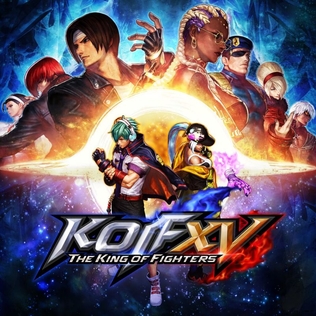
The King of Fighters XV, also called KOF XV, is a fighting game developed by SNK. It was released on February 17, 2022, for PlayStation 4, PlayStation 5, Windows, and Xbox Series X/S, while an arcade version, named The King of Fighters XV: Type Arcade, was published by Bandai Namco Amusement for Japanese arcade cabinets on Q1 2025, This is also the first game in The King of Fighters series created using Unreal Engine 4, and the first to implement GGPO rollback networking. Taking place after the events of The King of Fighters XIV, the narrative primarily revolves around two fighters with multiverse-related supernatural powers, Shun'ei and Isla, among other returning heroes facing revived threats. King of Fighters XV generally received praise for its character roster, team-based gameplay, and smooth online performance, but criticism for its story mode, complex tutorials, and mechanics.

















